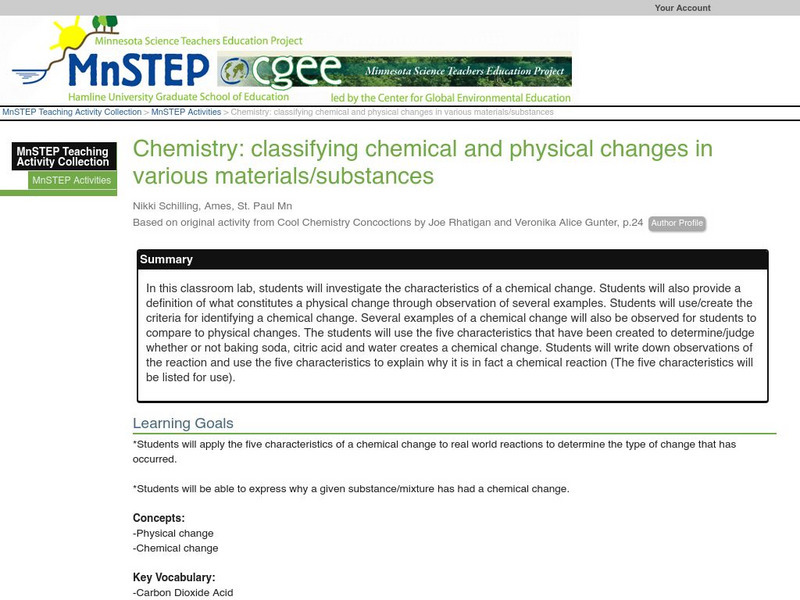Hi, what do you want to do?
Curated OER
Classification of Clouds
Students view a cloud slide show presentation and identify types of clouds. They estimate height based on cloud's appearance. They discuss the vague nature of cloud nomenclature and compare it to the English standard measurement system.
Curated OER
Poster Assignment: Sports Chemistry
Tenth graders distinguish between chemical and physical properties and changes in matter when given specific examples. They view a video of sports activities. Students chose their favorite sport and design an experiment to improve sports...
Curated OER
Taxonomy
Students analyze the complexity of organism classifications based on certain criteria. In this classifying organisms lesson students study taxonomy and gather information and leaves to do their own experiment on classification.
Curated OER
Vertebrate Skeletons
In this biology worksheet, students examine the human skeleton and then classify animal bones according to their similar function.
Curated OER
Where Do I Belong?
Tenth graders study the diversity of life in the world. They classify and sketch organisms into the 6 kingdoms.
Curated OER
Testing Battery Combinations
Fourth graders examine the required combinations of plates and predict which combination will generate the most and least current and voltage. They use an ammeter and experiment with combinations of their own testing and record each...
Curated OER
Evaporation
Students study the evaporation stage of the water cycle. For this water cycle lesson, students participate in an experiment to study the process of evaporation that uses jars and water. Students complete an observation worksheet for...
Curated OER
DNA Isolation from Plant Tissue
Students perform an experiment to extract and observe DNA from plant Tissue. They read about the procedure and relate it to the procedure used to isolate DNA from an endangered plant species. This is lesson plan three in a nine lesson...
Curated OER
Measuring Snowfall
Students predict the amount of snowfall for the week and measure snowfall. In this measuring snowfall lesson, student use a precipitation gauge to measure the week's snowfall; and analyze the data to determine whether or not...
Curated OER
WATTS UP?
Second graders research the Internet as they classify different forms of energy, investigate electrical energy and how to conserve energy.
Curated OER
Sort Laboratory Practice
Eighth graders sort animals according to certain physical characteristics. In this science lesson, 8th graders explain the reason for such classification. They complete a worksheet individually at the end of the lesson.
Curated OER
Taxonomic Keys
Seventh graders create their own dichotomous key. In this biology lesson plan, 7th graders classify animals based on their observable features. They explain how to use their dichotomous key.
Curated OER
Design your own Water Temperature Experiment
Students use Robolab sensors and software to design an experiment that incorporates the use of temperature probes. They conduct the experiment, complete a lab sheet, evaluate the results and then consider if their hypothesis requires...
Curated OER
Rocks Unit
Young scholars learn about all types of rocks through a unit study consisting of 6 days. They are doing activities such as illustrating rocks, answering questions on a worksheet, reading, and reviewing questions. After the end of each...
Curated OER
How Can You Detect the Invisible?
Students participate in a lab activity in which they examine the characteristics of radon. They identify radon's link to cases of lung cancer. They complete a radon fact sheet and answer questions to end the lesson.
Curated OER
Yeast
High schoolers study the characteristics of yeasts. In this biology lesson, students conduct experiments to measure yeast respiration. They discuss the favorable conditions needed for growing them.
Curated OER
Is Dilution the Solution to Pollution?
Students explore the different types of pollution. they conduct experiments using dye mixed with tap water to measure the levels of dilution. They discuss at what point the dye (pollution) would be diluted enough to be safe to drink.
Curated OER
Electromagnetic Bomb (E-Bomb)
Students explain how E-bomb works. In this physics lesson, students simulate the effects of e-bombs on electronic targets. They discuss its potential harmful effects when used as a weapon.
Curated OER
Mixtures
Sixth graders experiment with mixtures. In this chemistry lesson, 6th graders determine which mixtures are considered heterogeneous, a suspension, a solution or a colloid. Students create a data sheet of what they discover.
Curated OER
Using Newsprint as a UV Detector
Young scholars investigate the effects of UV radiation. In this earth science lesson, students explain how the time of day relate to UV abundance on Earth. They determine if weather affects the amount of UV that Earth receives.
Science Education Resource Center at Carleton College
Serc: Classifying Chemical and Physical Changes in Various Materials/substances
In this classroom lab, learners will investigate the characteristics of a chemical change. Students will also provide a definition of what constitutes a physical change through observation of several examples. Learners will use/create...
Science Education Resource Center at Carleton College
Serc: Investigating Wolf Behavior
In this classroom activity, students will observe different wolf behavior, facial expressions and body language to identify as either submissive or dominant behavior. Wolfs are observed in photos and short movie clips. Students will also...
Science Education Resource Center at Carleton College
Serc: Investigating Insects in Nature
In this lab, students will collect insects while making close observations of living things. They will then classify insects into seven common groups based on characteristics discussed in the classroom.



























